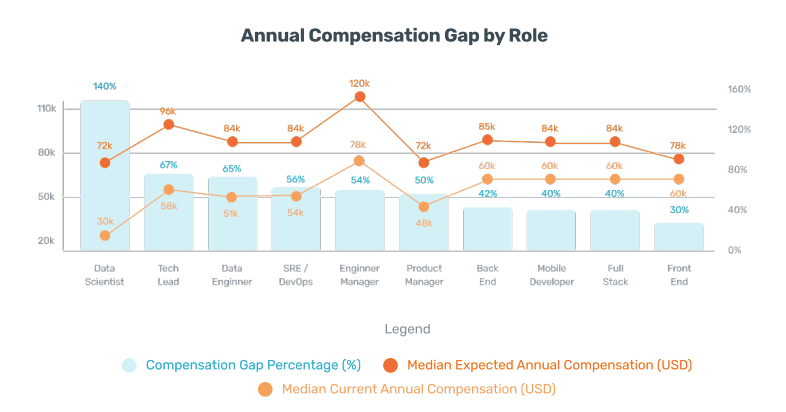During the current economic downturn, your company may be struggling to continue developing its product or product features while meeting goals and deadlines. As VC investment slows and companies trim costs to extend their present runways, some US companies are even being forced to make layoffs.
Even though there are no simple solutions in this uncertain and unstable tech market, you may keep your projects on track by working with remote tech talent from abroad. IT salaries from other regions present a significant opportunity for businesses to weather the downturn —and perhaps even thrive. In fact, regions like Eastern Europe and Latin America are currently in the spotlight for remote hiring and are booming with a wide pool of top-notch tech talent.
Let’s examine more closely why hiring software developers from Eastern Europe or Latin America is a wise move in the current market.
How can remote development teams help you stay afloat?
Numerous tech firms, especially those in the startup sector, have effectively adopted a work-from-home model, as remote work in the tech industry becomes the new global standard, reducing expenses while simultaneously maintaining a productive workplace.
It is undoubtedly advantageous to have a remote workforce, both in terms of financial costs and expenditures and in terms of team members’ productivity: by hiring remote software developers, you can automatically eliminate overhead costs that are tied to a physical office such as rent, utilities, office food and snacks, and much more. Additionally, because remote work reduces the need for needlessly long commutes and fosters a better work-life balance, it significantly increases employee productivity.
Another great thing about having a remote development team is that your company won’t be tied to the local pool of talent. Instead, a literal world of opportunities opens up, allowing you to find top workers globally. Moreover, employing people from other regions guarantees businesses that their teams will include a diverse range of opinions and viewpoints, which is also very advantageous.
How is hiring in Eastern Europe and LATAM a cost-effective solution?
As the economy continues to deteriorate, an increasing number of businesses are looking to expand their hiring efforts outside of the US. Let’s examine why hiring in Latin America and Eastern Europe is a financially advantageous way to address this crisis and cut costs.
Costs and advantages of remote hiring in Eastern Europe
Nowadays, the Eastern Europe region is in the spotlight for remote hiring. Both big and small software companies have shifted their attention to developers from this region, which has been seeing a hiring boom in recent years, also powered by the pandemic. Popular programming languages in the region include Java, .Net, Python, and PHP, among others which are in high demand by employers.
Professionals from the region have many years of expertise in a wide variety of segments in the tech market and can provide excellent services. Even more, not only do developers from Eastern Europe share cultural similarities with the US, but they also have a high level of English, which translates into an easy transition into your teams. Hiring software developers from the region means your company will be getting top-notch talent with favorable time zone differences that allow for a smooth collaboration.
In comparison to their US counterparts, Eastern European developers charge relatively low prices. For example, the average yearly salary of a software developer in the US is about $107,299, while in the countries of Eastern Europe this number is lower–about $44,899 per year. Let’s take a look at the current of software engineers in detail, grouped by country:
- The US – $108,160
- Bulgaria – $56,16027
- Croatia – $33,280
- Czech Republic – $66,560
- Hungary – $41,600
- Poland – $56,160
- Romania – $37,440
- Ukraine – $60,320
The average salaries of software developers mentioned above are the base salaries. It means if you hire engineers from these countries, consider that you will have additional expenses, such as bonuses, taxes, tools, and office rent.
Another option is to hire contractors either from the US or Eastern Europe. They are paid for working hours, so you can set a working day as it is convenient for both of you. In addition, you can quickly hire contractors as a helping part of your in-house team. It is especially beneficial if you need a developer with specific skills to start working on your project as soon as possible. For those thinking of hiring contractors, look at the average rates of developers according to YouTeam.
- The US – $102
- Bulgaria – $54
- Croatia – $58
- Czech Republic – $60
- Hungary – $57
- Poland – $59
- Romania – $56
- Ukraine – $59
Although the rates are lower compared to the US contractors, developers from Eastern Europe are still very skilled and have enough experience to provide high-quality software solutions.
Costs and advantages of hiring in Latin America
Latin America has recently been a center of economic growth and a desirable investment market for businesses, particularly those in the tech market. The region offers companies bright opportunities to hire software developers remotely due to the large number of top-skilled professionals that are available in the region.
Even though professionals in LATAM speak English as a second language, they have strong language skills and are proficient –much like their counterparts in Eastern Europe.
Additionally, due to Latin America’s proximity to the US, IT experts there have the cultural understanding needed to collaborate well in multinational teams.
When it comes to costs, US companies can save up to 60% on IT salaries by hiring in this region. It can be explained by the fact that the average salary in the US is about $107,299, while in the countries of Latin America, it is about $56,804 per year. Although hiring software developers from LATAM is less expensive, workers in this region are highly skilled, so you won’t have to compromise on quality. Due to this, American businesses have begun to recognize the advantages of hiring in Latin America.
The median annual tech salary in LATAM decreased by 10% during the second quarter of 2022, from $60,000 to $54,000, making hiring in the region all the more advantageous.
- The US – $108,160
- Brazil – $62,400
- Argentina – $45,760
- Chili – $54,080
- Uruguay – $45,760
- Ecuador – $47,840
- Colombia – $43,680
- Peru – $45,760
Another possibility is to hire contractors from the US or Eastern Europe. You can easily bring on contractors as part-time members of your in-house team. You would also pay them for their working hours, giving you the flexibility to schedule work around your day.
Having a developer with the precise skillset you need readily available is especially advantageous if time is of the essence for your project. YouTeam has created an infographic of average developer rates for anyone considering hiring contractors.
- The US – $102
- Brazil – $58
- Argentina – $52
- Chili – $61
- Uruguay – $55
- Ecuador – $58
- Colombia – $57
- Peru – $57
In terms of IT rates compared by role, professionals in Latin America have quite affordable prices, costing up to 60% less than their US counterparts:
Source: Nexton’s Compensation Trends report
How flexible is this solution for these uncertain times?
There are many advantageous solutions to remote hiring. Choosing the proper variation is dependent on many factors, including your budget, your location, the type of communication and workflow you want (asynchronous or synchronous), and what you’re looking for. Aside from building your own remote in-house team, there are two main options for hiring abroad:
Staff Augmentation
Through staff augmentation, you can fill vacancies on your own team. Usually, you’ll engage with a company in the tech market that charges you by the number of hours of development that you need for any given project. While this model makes it more challenging to integrate developers into your company culture and to form a close relationship with them, it allows you to scale your business quickly. YouTeam offers an advanced option—staff augmentation on demand. They handpicks the best-matched candidates from its pool of over 25,000 engineers, conducts personalized pre-screening, then arranges interviews for you. You save your time and focus by only reviewing the best candidates, and there is no need to contact lots of different agencies to find a match.
Browse 500+ Dev Teams Available for Hire
Let’s explore the cons and pros of choosing this hiring option.
Cons of Staff Augmentation:
Staff augmentation, as appealing as it may sound, is not suitable for every situation. When staff augmentation becomes the go-to strategy for longer-term projects, issues might occur.
- Onboarding: It’s challenging to integrate your augmented staff into your company culture, which could make collaborative tasks with your team members a difficult task. You should read this onboarding guide before start working with a contractor.
- Inadequate insight into worker satisfaction: It’s discouraging when an agency has a high turnover rate. This scenario often occurs because you have no knowledge about your augmented staff’s contentment with their compensation, benefits, and so on.
Pros of Staff Augmentation:
On the other hand, companies should choose staff augmentation for the following reasons:
– It’s a great solution for uncertain times, as it gives a lot of flexibility. You can hire contract engineers to move on and stop your collaboration if the economic situation or your plans are changed. Comparing to in-house hiring, it is less risky option.
– You can quickly find a great match for your particular needs. With YouTeam, you can hire the needed top-notch talent in a week.
– It works well when you’re looking to temporarily fill a talent gap on your team. And you don’t need to collaborate with one outsourcing agency only, staff augmentation on demand gives you an opportunity to choose the best developers from different companies to work on your project.
– If you’re developing a service or product that isn’t your main line of business, it helps avoid hiring a temporary in-house team.
The flexibility of this solution and the quality of the service depend a lot on the company you choose, which is why it’s crucial to look for highly skilled and expert agencies that provide you open access to your development team while enabling a direct line of communication.
Project Outsourcing
A good choice for businesses that wish to delegate their entire tech needs is to outsource the project (or a portion of it) to companies that specialize in constructing and delivering the finished product. This strategy works good for non-tech companies who want to develop and grow even during the crisis. Instead of hiring the entire development department, such companies can outsource the development process to the dev agency. Due to the expense associated with a full-scale partner, it also frequently costs more than staff augmentation. Let’s examine both the pros and cons of this hiring model:
Cons of Project Outsourcing:
- Lack of control: with project outsourcing, there is a risk of losing control of the project, since the hired agency is the one that has authority -and visibility- over the development team.
- Security concerns: Sensible business information may be divulged depending on the nature of the outsourced project, which can be an issue if the outsourced staff work for a rival. Another potential issue here is confidentiality. Companies choosing to outsource their project should be cautious if their business handles sensitive information.
- Communication: In collaborative projects, a seamless communication is critical. Directions might become jumbled when there’s not a clear channel of communication. Moreover, if you don’t have a direct line of communication with the outsourced team or company, you might lose control over the direction of the project -and perhaps even its quality.
Pros of Project Outsourcing:
Companies choose this model of hiring for the following reasons:
– It’s ideal when you don’t have your own development team.
– Since this model is more hands-off, it allows you to concentrate on other company goals and needs.
– It’s scalable if you find the right company to partner with.
In the end, outsourcing may be the best option for businesses that value speed and scalability above all else but do not wish to develop a long-term relationship with the development team.
To summarize
Since recessions and worsening economic conditions frequently force businesses to lay off employees, hiring in Eastern Europe or Latin America gives you the bright opportunity to distinguish yourself from the competition and speed up the hiring process as a tactical leader. This may prove advantageous for your company, given that development teams allow you to keep developing your product while meeting company deadlines.
Both Staff Augmentation and Project Outsourcing are great, flexible solutions for these uncertain times, as your company can move on with the development process while avoiding the potential risks of in-house hiring in case the current market situation worsens.
Find out more steps companies can take during uncertain times.








